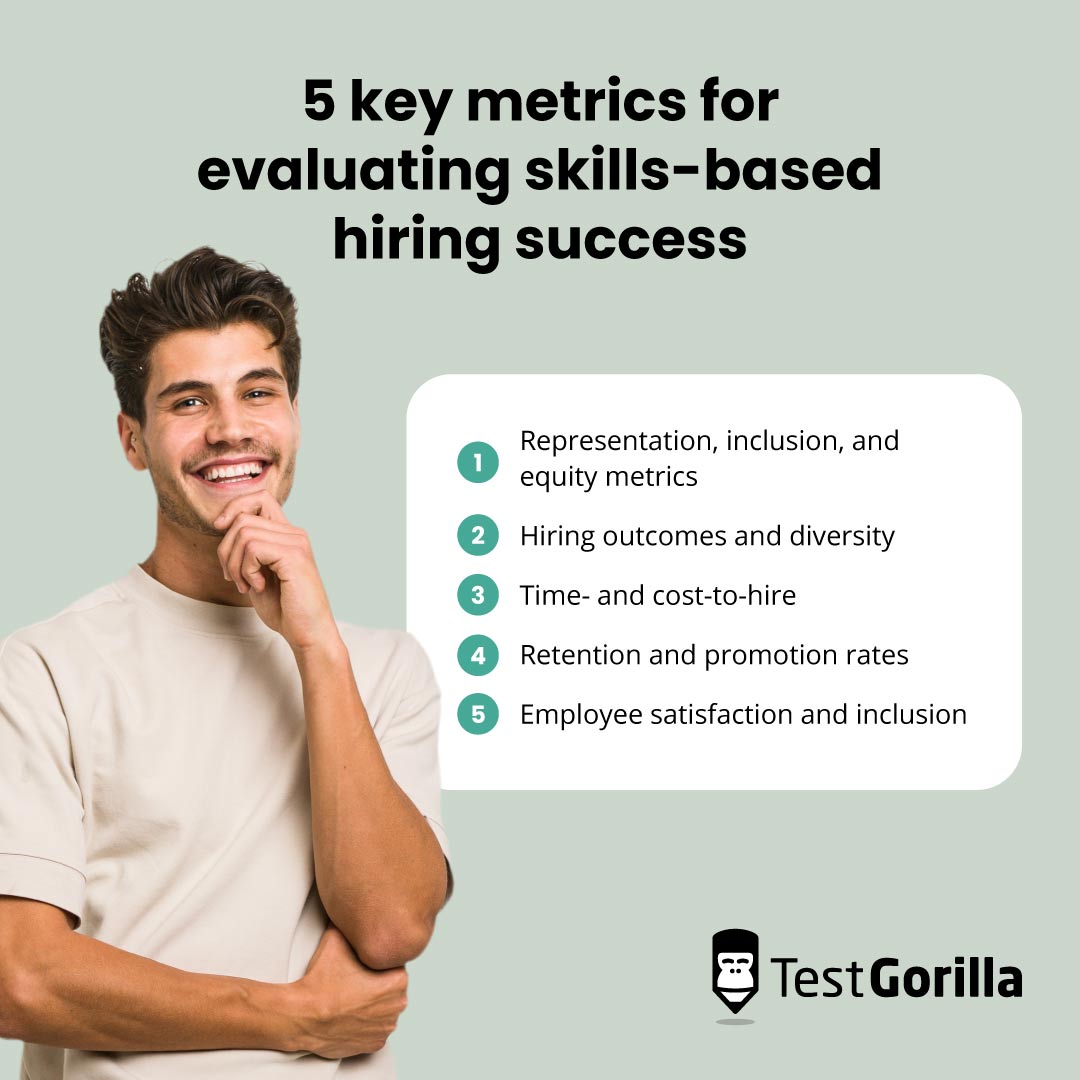Skills-based hiring provides a fairer way to assess candidates and foster more diverse, inclusive, and high-performing teams.
However, its impact is limited if practices are only half implemented.
Without tracking and measuring the success of your skills-based hiring process, you’ll struggle to optimize your talent acquisition strategy fully. You may still be under-representing particular groups, adding inefficiencies into your hiring process, or missing opportunities to improve the employee/candidate experience.
In this piece, we look at the metrics you can use to assess the effectiveness of your skills-based hiring and explore how you can leverage data to move toward your diversity and inclusion (D&I) goals.
Table of contents
Skills-based hiring levels the playing field for diverse candidates. This is because all applicants are assessed on objective criteria and scientifically-backed testing rather than on their educational background information and past experience. This mitigates the disadvantage faced by underprivileged candidates who might not have had access to the same opportunities or education as others.
Traditional hiring practices that heavily rely on resumes and experience tend to favor candidates from certain educational institutions or industries, inadvertently excluding potentially qualified individuals from other backgrounds.
Skills-based hiring, on the other hand, encourages people with transferable skills and diverse experiences to apply, ensuring that a more comprehensive and diverse talent pool is considered during the recruitment process.
Consider the candidate who has never been to university because of income issues, but has run a successful social media account for their parent’s cafe. On paper, they may not meet your role requirements, but with skills-based hiring, you can spot whether they have the marketing and personal skills needed on your team.
By swapping resumes for an analysis of hard and soft skills, the impact of unconscious bias on hiring decisions is also heavily reduced.
Our 2022 State of Skills-based Hiring report found that 91.1% of companies that implemented skills-based hiring saw an increase in workplace diversity. 28.7% of these organizations saw “significant” improvement in diversity without implementing any other changes.
But how is this improvement in diversity measured? We’ll look at that in the next section.
There's strength in numbers
Tracking the impact of skills-based hiring and D&I efforts is vital to maximize the impact of these practices. With insights about team composition and candidate sentiment, you can recognize when goals are being met. With data about your recruitment process, you can identify areas of improvement. For example, by assessing how long it takes you to hire using traditional methods vs skills-based hiring, you can find the most streamlined process.
What’s more, with a complete picture of your D&I status, you also manage the risk of being accused of woke washing. Transparency around your data and initiatives allows you to demonstrate the authenticity of your commitment and present tangible evidence of the progress made.
In the next section, we take a closer look at the key metrics you should track to achieve this.
Key metrics for evaluating skills-based hiring success
By comparing data for candidates hired using talent assessments vs those recruited through other methods, such as referrals or resume-based approaches, you gain a comprehensive understanding of the impact of skills-based hiring.
In this section, we look at the following methods for obtaining insights:
Representation, inclusion, and equity metrics
Hiring outcomes and diversity
Time- and cost-to-hire
Retention and promotion rates
Employee satisfaction and inclusion
Representation, inclusion, and equity metrics
To understand whether your skills-based hiring practices are translating into real-life D&I improvements, you should first take a look at:
Representation metrics: Measure the composition of different demographics in your organization. This allows you to track the representation of diverse talent at different levels and identify any imbalances. Google’s Diversity Annual Report, which details the company’s D&I actions and results, is a good example of this.
Inclusion metrics: Take surveys to assess employee engagement, satisfaction, and belonging. This allows you to evaluate how well your organization is fostering an inclusive environment after hiring.
Equity metrics: Look at pay equity, promotion rates, and resource allocation to examine whether there are disparities in compensation, career advancement opportunities, and access to resources among different employee groups.
Hiring outcomes and diversity
You can objectively measure the impact of your skills-based hiring practices by looking at the impact they’ve had on how many people from underrepresented groups apply and are hired for your positions.
As Monica McCoy, chief executive officer and founder of Monica Motivates, says, “If the group applying for a position is more diverse than it was before a skills-based approach was introduced, then it’s clear that the previous approach excluded certain candidates.”
Retention and promotion rates
You need to go beyond looking at hiring rates and assess whether skills-based hiring is fostering inclusion and effective opportunities for advancement further down the line. This means monitoring retention rates, analyzing promotion data, and evaluating opportunities for reskilling and upskilling across departments.
Skills-based hiring practices make it particularly easy to identify skills gaps and track the progression of employees' skills and competencies over time. By aligning the hiring process with the specific skills required for each role, you can systematically evaluate how well employees are developing and using their skills within the organization.
Additionally, a natural consequence of skills-based hiring is recruiting people with different perspectives, backgrounds, and experiences to your team. This creates a more inclusive and psychologically safe environment for employees who may otherwise feel alienated from your company culture, and you can measure how this aids in retention and engagement.
Time and cost to hire
Our report shows that 91.4% of companies saw a decrease in time-to-hire and 89.8% saw a reduction in hiring costs by implementing skills-based hiring. Assess the impact in your own organization by:
Comparing expenses associated with both skill-based hiring and traditional recruitment methods, making sure to remember hidden costs such as posting on job boards.
Assessing the time it takes to fill vacant positions by defining a clear starting point and an end date (when the selected candidate accepts the offer) and using an applicant tracking system to save time on calculations.
Benchmarking against data on standards which you can find through industry reports and surveys.
6 best practices for measuring the impact of skills-based hiring
To avoid offering merely the illusion of inclusion, organizations must implement robust strategies for measuring the impact of skills-based hiring on diversity, inclusion, and workplace culture. In this section, we explore how you can go beyond surface-level assessments.
1. Define your goals
To accurately track data about skills-based hiring, you first need to decide on what your goals are when implementing it. To define these, use industry benchmarks provided by organizations such as Opportunity@work, which aims to advance economic mobility for workers skilled through alternative routes (STARs), and OneTen which aims to achieve greater representation for Black individuals.
You should also log data about your current hiring processes. As Monica says:
“It’s important that you have a clear understanding of how your organization looks and functions before you make the switch to skills-based hiring… This is a really good opportunity to evaluate roles and role descriptions in a focused and intentional way to ensure they actually correspond to company needs.”
2. Collect and analyze comprehensive demographic data
According to our research, over a third of companies not using skills-based hiring didn’t have processes in place to track things like unconscious bias. Create a standardized method of data capture throughout the recruitment process and employee lifecycle to ensure that all insights can be directly compared with non-skills-based hiring metrics.
This might look like using the same, anonymous survey questions to assess employee sentiment. Monica points to these “regular anonymized surveys” as a great way to “measure how included employees feel in the organization.” For example, questions can include:
How would you rate your overall satisfaction with your current role and responsibilities?
Do you feel your skills and abilities are utilized effectively in your current position?
On a scale of 1 to 10, how likely are you to recommend this organization as a great place to work?
Are you satisfied with the opportunities for career growth and advancement within the company?
How comfortable do you feel sharing your ideas and opinions with your immediate supervisor?
Do you believe the company values diversity and inclusion in its workplace?
How well do you think the organization communicates its goals and strategies to employees?
Are you receiving the necessary support and resources to perform your job efficiently?
Do you feel that your contributions are recognized and appreciated by your colleagues and superiors?
How satisfied are you with the work-life balance provided by the organization?
3. Regularly review and report metrics to track progress
As Monica says, “It’s most useful to establish targets connected to areas that will benefit directly from skills-based hiring, so you can eliminate any other contributing factors from the equation.” Considering factors such as demographic representation and employee progression allows you to continuously, directly gauge the impact of your skills-based hiring practices.
From here, you can identify areas that require adjustment. For example, you might optimize your job ad wording to reduce language that may be subconsciously off-putting to a particular demographic. Alternatively, after tracking employees’ skills progress – for example, in annual talent assessments – you could identify areas where additional training or upskilling opportunities are needed to support career growth.
4. Gather qualitative feedback
To understand the impact of your skills-based hiring policies on the day-to-day lives of your employees, you need qualitative data. Focus on collating insights from anonymous surveys, but also interviews, ERGs, and focus groups where you get a chance to follow up with questions. For example, you can ask:
What aspects of your job do you find most enjoyable and fulfilling on a day-to-day basis?
What are some challenges you encounter in your daily work, and how do you handle them?
Can you share examples of how your team collaborates and communicates throughout the day to achieve common goals?
How do you feel your skills and expertise are valued and utilized by your colleagues and supervisors?
Are there any opportunities for learning and growth integrated into your daily work routine?
You can also look to external insights to build out a wider picture. Monica says: “It can be useful to use surveys or social media sentiment analysis to understand perceptions of your brand. We know that younger demographics care deeply about diversity, equity, and inclusion in the brands and companies they buy from. You may be able to get a sense from those groups of whether your brand is seen to be committed to DEI.”
5. Conduct exit interviews
As the Great Resignation highlighted, employees have no problem leaving a company where they don’t feel adequately supported. Exit interviews provide the perfect opportunity to understand problems that employees may not voice while still in their role.
To evaluate the impact of your skills-based approach in this light, ask questions like:
Did you feel that your skills and qualifications were accurately assessed during the hiring process, and did this align with your actual job responsibilities?
Did the skills-based hiring approach contribute to a more diverse and inclusive work environment, or were there any aspects that could be improved in this regard?
Were there any specific skills or training opportunities that you believe could have enhanced your performance or job satisfaction within the organization?
6. Calculate your return on investment
To understand the ROI of your SBH practices, you can make goals and predictions using an ROI calculator. This takes into account factors such as recruitment agency fees and job boards to show you how much you could save.
You can then track your actual ROI by combining these data points:
Time-to-hire
Reduction in costs associated with traditional hiring methods
Any increases in employee retention
Skills-based hiring metrics and best practices: Stay on track as you scale D&I
Skills-based hiring gives you a fairer way to hire the right people for your open roles based on skills and competencies, not who they are, where they went to school, or where they come from. This lets you tap into a pool of diverse global talent and build more diverse, inclusive teams.
By tracking, measuring, and understanding the impact of your skills-based hiring practices, you can further streamline your recruitment model and understand how it contributes to boosting D&I.
To accurately measure impact, you need to look at both data and qualitative insights. This means:
Representation, inclusion, and equity data
Hiring outcomes
Time and cost to hire
Retention and promotion rates
Employee satisfaction and inclusion
By regularly assessing your progress in these areas, you can take targeted action to improve the candidate and employee experience. This ensures that your company growth and D&I initiatives are based on solid data to set you up for success.
Hire the right people and boost D&I. Skills-based hiring lets you recruit based on solid, objective data – and build a more inclusive workplace that appeals to top talent. Download the State of Skills-based Hiring 2022 report to learn more |
Related posts
Hire the best candidates with TestGorilla
Create pre-employment assessments in minutes to screen candidates, save time, and hire the best talent.
Latest posts
The best advice in pre-employment testing, in your inbox.
No spam. Unsubscribe at any time.

Hire the best. No bias. No stress.
Our screening tests identify the best candidates and make your hiring decisions faster, easier, and bias-free.
Free resources
This checklist covers key features you should look for when choosing a skills testing platform
This resource will help you develop an onboarding checklist for new hires.
How to assess your candidates' attention to detail.
Learn how to get human resources certified through HRCI or SHRM.
Learn how you can improve the level of talent at your company.
Learn how CapitalT reduced hiring bias with online skills assessments.
Learn how to make the resume process more efficient and more effective.
Improve your hiring strategy with these 7 critical recruitment metrics.
Learn how Sukhi decreased time spent reviewing resumes by 83%!
Hire more efficiently with these hacks that 99% of recruiters aren't using.
Make a business case for diversity and inclusion initiatives with this data.



















